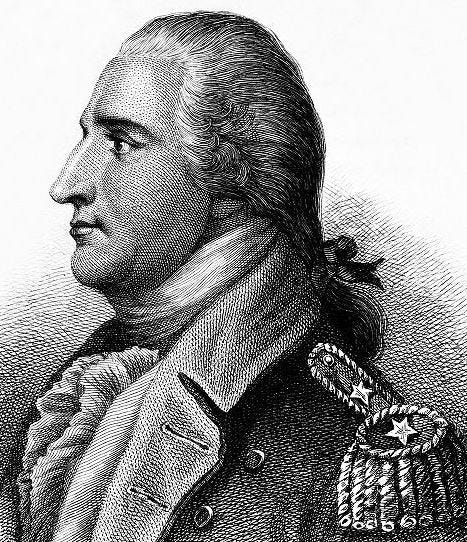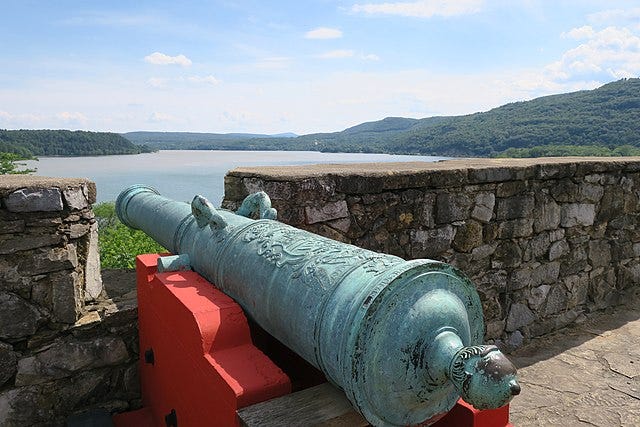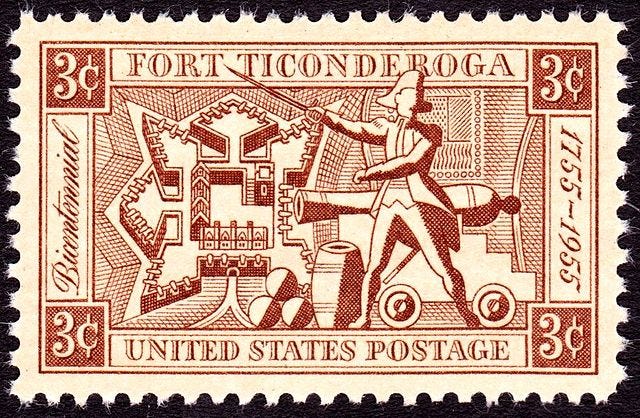Today is the anniversary of a critical but neglected Revolutionary War event. A band of patriots crossed Lake Champlain during the night of May 10, 1775. Before dawn they had captured Fort Ticonderoga, the most strategic fortification in the colonies. The first offensive expedition of the war ended in victory.
Violence had erupted at Lexington and Concord only three weeks earlier. The capture of Ticonderoga had an outsized impact on the course of the war. The fort was crucial for defending the Champlain Valley, which led from Canada into the heart of the colonies.
Ticonderoga quickly proved its value. Later in 1775 it became the base from which the patriots launched their invasion of Canada. That attack delayed British hopes of splitting the colonies by taking control of the corridor that ran down Lake Champlain, Lake George, and the Hudson River.
The operation paid additional dividends. In 1775 George Washington’s makeshift force was besieging the British Army in Boston. Because they lacked artillery, the Americans could do nothing to dislodge the enemy and were vulnerable to a counterattack. During the winter of 1775-76, patriots packed some of the massive cannon at Ticonderoga onto sleds and dragged them across the entire state of Massachusetts. In March, Washington used the guns to force the enemy out of Boston.
Although the capture of Ticonderoga was among the most critical operations of the war, the history books have given it only glancing attention. Two factors explain the neglect.
The first is the fact that the takeover did not involve a large battle. So slow were communications during the eighteenth century that the soldiers at the fort — there were only about fifty redcoats there, some with their families — did not know that the war had started. The fort’s commander, Captain William Delaplace, did not have his troops on high alert — the night of the takeover they were fast asleep.
The second factor that has influenced historians is that the capture was led by Benedict Arnold. A successful New Haven businessman when the war began, Arnold had marched off to fight as soon as he heard. Arriving in Boston a few days later, he proposed the raid to Massachusetts authorities. They gave him the rank of colonel and sent him to raise a force in the western part of the state to attack the fort.
Arnold crossed the state on horseback and, on arriving, found that a group of armed men were already preparing to attack the fort. They were the Green Mountain Boys, a vigilante group organized by Ethan Allen to contest land claims east of the lake. Allen had been unofficially commissioned by Connecticut politicians to take the fort.
After a stare-down, Arnold and Allen shared command of the raiding party. They crossed the lake in a barge on a stormy night. With 83 citizen-soldiers, they rushed the main gate and caught defenders in their night clothes. When Delaplace asked on what authority they were seizing the fort, Allen supposedly claimed they acted “in the name of the Great Jehovah and the Continental Congress!”
Jehovah’s views were not recorded, but Congress knew nothing of the operation. The delegates, who had convened in Philadelphia that same May 10, were appalled to hear the fort had been taken. Determined to seek reconciliation with Britain, they ordered Ticonderoga to be returned to the Crown. Although they quickly rescinded the order, it revealed the uncertainty that marked the early days of the war.
Arnold didn’t stop there. While members of the Green Mountain faction got drunk and headed home for spring planting, he rigged cannon on a lake schooner and sailed north into Canada, where he captured the only British warship on the lake.
Control of the fort and surrounding waters proved crucial for fending off the British attack a year later. The British sent seven thousand soldiers to Canada in the spring of 1776 to attempt the invasion. Combined with their direct attack on New York City that summer, such an incursion may have quickly defeated the patriot cause. Instead, the patriots, led by Benedict Arnold, opposed the enemy on Champlain and delayed them until the approaching winter caused them to give up the effort for that year.
It wasn’t until 1777 that the king’s forces were able to recapture Ticonderoga as part of General John Burgoyne’s invasion. That foray ended in a British disaster at Saratoga. Again, Arnold was the essential man in that “turning point” victory.
After Arnold committed treason in 1780, chroniclers tried to downplay his early heroism by diminishing his achievements. The result is the neglect of some of the most significant patriot victories of the early part of the war.
Click the IMAGE below to pick up a copy of GOD SAVE BENEDICT ARNOLD and read more about the adventures of America’s most heroic traitor. For a collector’s copy signed by the author, here’s the LINK.
On Saturday, May 18 at 1:00 pm, I’ll be giving a talk twenty miles from Ticonderoga at the Lake Champlain Maritime Museum (4472 Basin Harbor Road, Vergennes, Vermont). Excellent museum featuring a replica of the famous gunboat Philadelphia. For more info, click HERE.









Did the Jehovah's ring the doorbell at the fort to gain entrance?
Thank you again Jack for an interesting read. I enjoyed it as well.